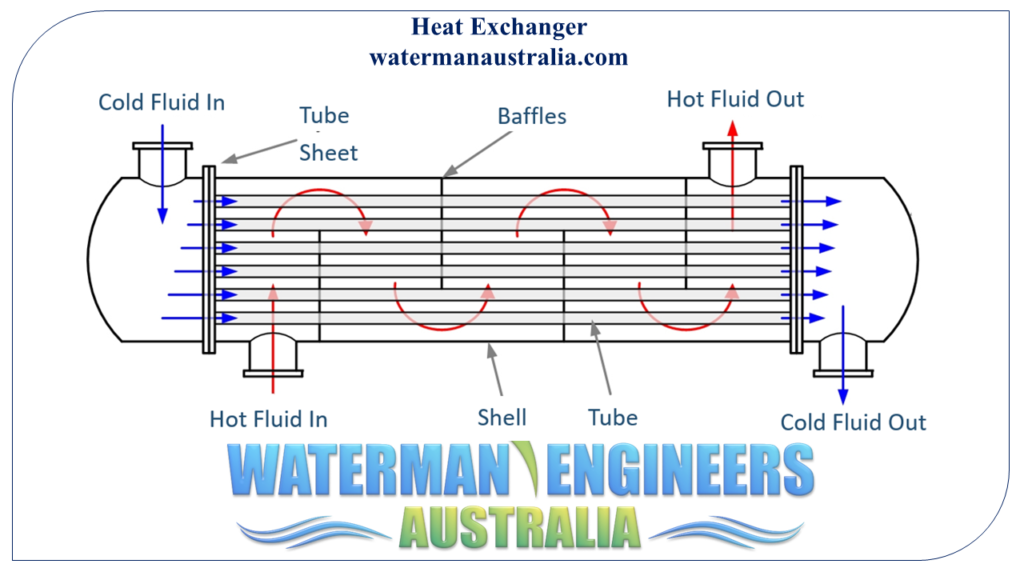
A heat exchanger is a device that allows for the transmission of heat between two different media without any physical contact between them. Heat exchangers work on the idea that thermal energy can be transferred from a hot fluid to a cold fluid. Heat exchangers provide for precise temperature regulation, improving energy efficiency and system functionality by transferring heat between two fluids.
Power plants, chemical plants, HVAC (heating, ventilation, and air conditioning) systems, supermarkets, and many more all employ heat exchangers. They can be found in commonplace home products like air conditioners and water heaters.
In this article, we'll learn about heat exchangers, what they are, how they work, and the different kinds there are. The article also details the common uses and factors to consider when choosing a heat exchanger.
A heat exchanger involves two flowing fluids separated by a stable wall. Heat is transferred through the sizzling fluid on the wall by convection, throughout the wall by conduction and with the wall on the cold fluid by convection.
A prior write-up introduced suggestions for Value-effective recommendations with the equipment’s design and style, components, and fabrication. Its objective was to enable the challenge engineer, that is not an devices professional, to check that inexpensive possibilities are made throughout all included disciplines.
Tie rods are round metal rods screwed into the stationary tubesheet and secured with the farthest baffle by lock nuts. The amount of tie rods is determined by shell diameter which is specified, by TEMA.
The more modern furnaces, instead, use what is known as a scorching surface igniter (HSI). This is often a comparatively new technological innovation that involves an electric current passing from the igniter, increasing the temperature, and initiating combustion when the fuel supply is switched on.
Two forms of flow arrangement are achievable inside a double-pipe heat exchanger: parallel stream and counter flow. In parallel circulation, both of those the cold and hot fluids enter the heat exchanger at the same stop and go in a similar route, as revealed in Determine one.
In case the exchanger type and sizing are acknowledged plus the fluid outlet temperatures should be decided, the application is called a overall performance calculation trouble. These kinds of troubles are very best analysed through the NTU-performance technique [four, 5].
ASME and TEMA give two other ways of calculating the tubesheet thickness. TEMA’s calculation is much less refined than ASME’s as it doesn't take into account the rigidity provided by the shell as well as stationary head.
In more mature fuel furnaces, a pilot light-weight burns continuously which lights the gas. The instant the fuel furnace is turned on, the pilot light is able to ignite the fuel and begin the heating system.
The type of heat exchanger is indicated by course of action on the process facts sheet. Because the system engineer is hardly ever informed about the expense of Every kind, an uneconomical choice could be manufactured.
A photograph with the EAHX during development is introduced in Determine three. This photograph shows a trench, the EAHX air intake At first with the trench and two parallel pipes leaving this air intake in direction of the air managing device (the latter not seen).
The weld neck flange form, which has a tapered hub which has a smooth pressure changeover and accessibility for entire nondestructive assessment, supplies the very best integrity of your a few kinds. A flange consists of a few subcomponents: the flange ring, the gasket and the bolting. The profitable Procedure on the flange is determined by the right option, structure and assembly of these subcomponents. The Heat Exchange Designing of heat exchanger manufacturer Design and style Handbook has two chapters speaking about these factors.
Most heat exchangers are categorized In accordance with their construction, heat transfer approach as well as their surface area compactness. That is the quantity of area location with the heat to dissipate from or transfer much too in comparison with the Bodily size.
Although standard heat-pump air conditioners use fluorocarbon refrigerants that contribute to global warming, reducing the refrigerant demand tends to reduced heat exchanger efficiency. To cut back refrigerant demand as well as improve heat exchanger functionality, Mitsubishi Electrical focused on lessening The interior volume of the heat exchanger and expanding the floor region of air in contact with the refrigerant, partially by compactly arranging a large number of modest-diameter flat tubes.
The usage of the method is clearly facilitated by expertise in the cold and hot fluid inlet and outlet temperatures.